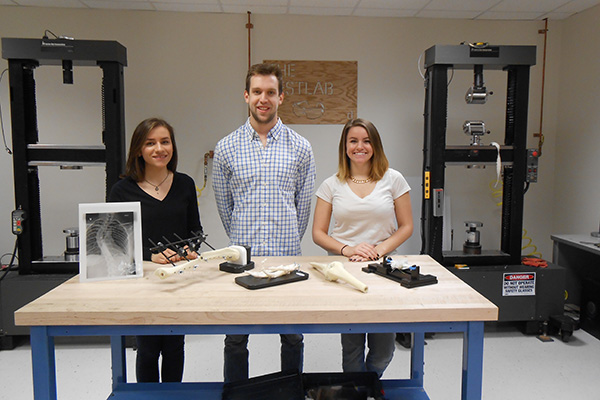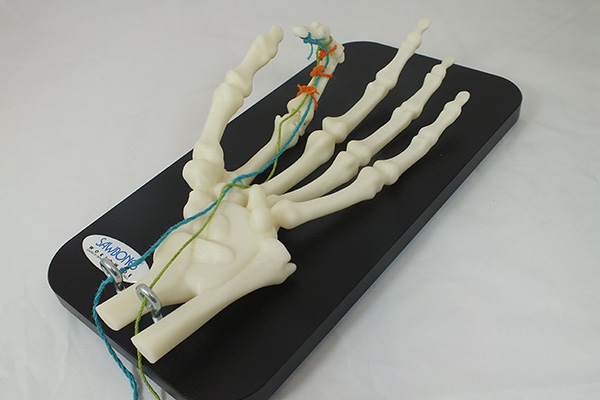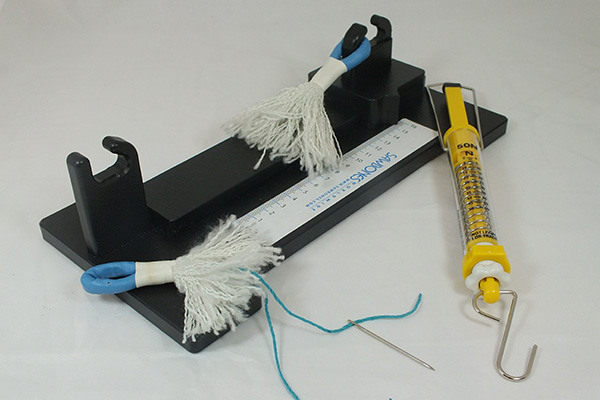


Orthopaedics in Action
UD faculty, students in engineering, education collaborate to create STEM materials
2:16 p.m., March 23, 2015--An interdisciplinary team of students and faculty from University of Delaware’s College of Education and Human Development and College of Engineering have developed unique curriculum kits, called Orthopaedics in Action (OIA), that teach science, mathematics and engineering concepts through medical experiments.
OIA was created to bridge the gap between engineering and biomedical sciences in high school and middle school classrooms, and to increase student exposure to science, technology, engineering and mathematics (STEM) curriculum across the country.
Campus Stories
From graduates, faculty
Doctoral hooding
Five different kits offer interactive hands-on lessons for students to immerse themselves in orthopedics and engineering concepts such as geometry, forces and motions, structural design and trigonometry.
Each kit is aligned with Next Generation Science Standards and includes anatomical models and biomechanical testing stations, lesson plans, handouts and video tutorials.
Kits include:
- A broken tibia for students to repair using an orthopedic implant called an external fixator, or “ex-fix;”
- A knee for diagnostic testing;
- Spinal x-rays to examine scoliosis;
- A hand that demonstrates pulley systems; and
- A torn Achilles tendon to practice surgical suturing techniques.
“The OIA project was originally developed as part of the Perry Initiative, a non-profit organization that inspires young women to be leaders in orthopedic surgery and engineering,” said Jenni Buckley, assistant professor of mechanical engineering and co-founder of The Perry Initiative. “As the students’ anatomical model prototypes were being finalized, I thought it would be beneficial to bring in an education professional to see how OIA could be implemented in classrooms.”
Amy Trauth-Nare, associate director for science education at UD’s Professional Development Center for Educators, was able to provide that expertise. She helped Buckley develop learning objectives, create pre- and post-surveys to measure effectiveness, craft precise language for instructional material, and identify the amount of digestible information for students.
“This project is important because it brings engineering to K-12 classrooms,” said Trauth-Nare. “Regardless of their backgrounds, students can engage in engineering design grounded in authentic contexts.”
Creative design process
The first generation OIA curriculum was designed through the Interdisciplinary Senior Design Program (MEEG401/BMEG450), by a team of biomedical engineering seniors. Buckley and Dustyn Roberts, assistant professor in mechanical engineering, advised the students -- including Manuela Restrepo, Emily Pavilonis, Ryan Locke and Jeannie Kontos -- as they conducted extensive background research, comparing more than 200 orthopedic procedures to determine the best concepts to teach.
Building off the Perry Initiative’s first classroom kit focused on scoliosis, the team developed four additional biomedical engineering curriculum units, creating prototypes models of the knee, tibia, hand and Achilles tendon.
Based on the design team’s prototypes, Buckley contacted Pacific Research Labs, makers of Sawbones anatomical models, to manufacture and distribute classroom materials for the OIA kits. Buckley then reached out to UD alumna and professional graphic designer Sarah Minnich, a plant and soil science major who received a bachelor’s degree in 2010 and a master’s in 2013, to illustrate the instructional slides and worksheets for the OIA lessons.
The team also received early feedback from The Perry Initiative’s national partner, Project Lead The Way Inc., and funding support from two major medical device firms, Zimmer Inc. and Stryker Corp., to help with development and launch costs.
OIA in the classroom
In January, Trauth-Nare and students Restrepo and Pavilonis, supported through a Winter Service Learning Scholarship, traveled to high schools in Delaware and Maryland to observe students utilizing the OIA kits.
Graduate students Charlotte Marshall and Matt Deegan, from UD’s social psychology program, assisted the team in developing the evaluations. To measure the effectiveness of the lesson plans, teachers were given pre and post surveys that were used to refine the curriculum.
“OIA gives high school teachers something simple yet robust to teach engineering,” said Trauth-Nare.
“Challenging students in inquiry lessons like those created by OIA gives them an chance to use creativity and logic to find the best solution instead of the correct one. Students in my anatomy and physiology classes have continued to refer back to the modules both in content and in process,” said Wendy Pasmore, a STEM lead teacher at Elkton (Maryland) High School.
During the design process, the team made over a dozen classroom visits and spent countless hours developing OIA in an effort to create dynamic classroom materials will inspire students to pursue careers in the STEM fields.
“It is our hope that these kits will impact the field and generate statistically significant results,” said Locke. “These kits help teachers, as well as students meet the new NGSS standards, overall helping the education of our society.”
Presenting the products
The team will launch their OIA kits at the 2015 American Association of Orthopaedic Surgeons annual meeting in Las Vegas, March 24-28. They will also present their materials at the 2015 Ruth Jackson Orthopaedic Society meeting, the preeminent professional organization for women orthopedic surgeons.
OIA curriculum will be available for purchase through the Sawbones website. The goal is to have OIA kits in 100 classrooms by the end of 2015.
“There is absolutely nothing like this out there,” said Buckley. “We couldn’t have done this without a partnership with our education colleagues. OIA is a great example of ‘Integrated STEM,’ not just because the curriculum is integrated but also because the entire process of creating this curriculum was so interdisciplinary.”
Article by Elizabeth Adams
Photos by Laura Edmonson and Ryan Locke










